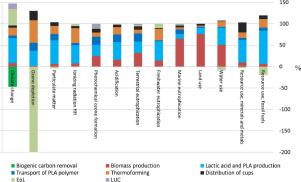Resources, Conservation and Recycling ( IF 13.2 ) Pub Date : 2021-02-24 , DOI: 10.1016/j.resconrec.2021.105508 Christian Moretti , Lorie Hamelin , Line Geest Jakobsen , Martin H Junginger , Maria Magnea Steingrimsdottir , Linda Høibye , Li Shen

|
Polylactide (PLA) is both bio‐based and biodegradable and has therefore attracted increased attention for single-use plastics applications. Under the context of the recent EU Plastics and Bioeconomy strategies, this study uses life cycle assessment (LCA) to assess the environmental footprint of single-use drinking cups made from PLA, including 13 environmental impact categories. Land use changes (LUCs) were assessed based on a deterministic model. The manufacturing phase was modeled based on primary production data stemming directly from the industry. The end-of-life (EoL) impacts were assessed using the EASETECH. PLA cups were then compared with their petrochemical counterparts polyethylene terephthalate (PET) and polypropylene (PP) cups. Based on the available data quality of the petrochemical polymers, six impact categories were compared. For PLA cups, the process energy use in the conversion from biomass to PLA polymer was identified as the main environmental hotspot, followed by the electricity consumption of thermoforming of the cups. It was found that the biomass acquisition phase has a limited overall impact. LUCs contribute to a negligible impact in all impact categories except for climate change and photochemical ozone formation. Compared to PET cups, the current PLA cups offer environmental impact savings for climate change even including the impacts of LUC. Compared to both PET and PP cups, PLA cups offer savings for fossil fuels resource use but lead to higher impacts for photochemical ozone formation, acidification and terrestrial eutrophication.
中文翻译:

从PLA,PP和PET制成的一次性杯子的从摇篮到坟墓的生命周期评估
聚乳酸(PLA)既可生物降解又可生物降解,因此在一次性塑料应用中引起了越来越多的关注。在最近的欧盟塑料和生物经济战略的背景下,本研究使用生命周期评估(LCA)评估了PLA制造的一次性饮用杯的环境足迹,包括13种环境影响类别。基于确定性模型评估土地利用变化(LUC)。根据直接来自行业的主要生产数据对制造阶段进行建模。使用EASETECH评估寿命终止(EoL)的影响。然后将PLA杯与石化产品的聚对苯二甲酸乙二醇酯(PET)和聚丙烯(PP)杯进行比较。根据石化聚合物的可用数据质量,比较了六个影响类别。对于PLA杯子,从生物质到PLA聚合物的转化过程中使用的能源被确定为主要的环境热点,其次是杯子热成型所需的电能。发现生物质获取阶段具有有限的总体影响。LUC在所有影响类别中的影响都可以忽略不计,除了气候变化和光化学臭氧的形成。与PET杯相比,当前的PLA杯可为气候变化节省环境影响,甚至包括LUC的影响。与PET和PP杯子相比,PLA杯子可节省化石燃料资源的使用,但对光化学臭氧形成,酸化和陆地富营养化的影响更大。其次是杯子热成型的电力消耗。发现生物质获取阶段具有有限的总体影响。LUC在除气候变化和光化学臭氧形成以外的所有影响类别中的影响都可以忽略不计。与PET杯相比,当前的PLA杯可为气候变化节省环境影响,甚至包括LUC的影响。与PET和PP杯子相比,PLA杯子可节省化石燃料资源的使用,但对光化学臭氧形成,酸化和陆地富营养化的影响更大。其次是杯子热成型的电力消耗。发现生物质获取阶段具有有限的总体影响。LUC在除气候变化和光化学臭氧形成以外的所有影响类别中的影响都可以忽略不计。与PET杯相比,当前的PLA杯可为气候变化节省环境影响,甚至包括LUC的影响。与PET和PP杯子相比,PLA杯子可节省化石燃料资源的使用,但对光化学臭氧形成,酸化和陆地富营养化的影响更大。LUC在除气候变化和光化学臭氧形成以外的所有影响类别中的影响都可以忽略不计。与PET杯相比,当前的PLA杯可为气候变化节省环境影响,甚至包括LUC的影响。与PET和PP杯子相比,PLA杯子可节省化石燃料资源的使用,但对光化学臭氧形成,酸化和陆地富营养化的影响更大。LUC在除气候变化和光化学臭氧形成以外的所有影响类别中的影响都可以忽略不计。与PET杯相比,当前的PLA杯可为气候变化节省环境影响,甚至包括LUC的影响。与PET和PP杯子相比,PLA杯子可节省化石燃料资源的使用,但对光化学臭氧形成,酸化和陆地富营养化的影响更大。


























 京公网安备 11010802027423号
京公网安备 11010802027423号